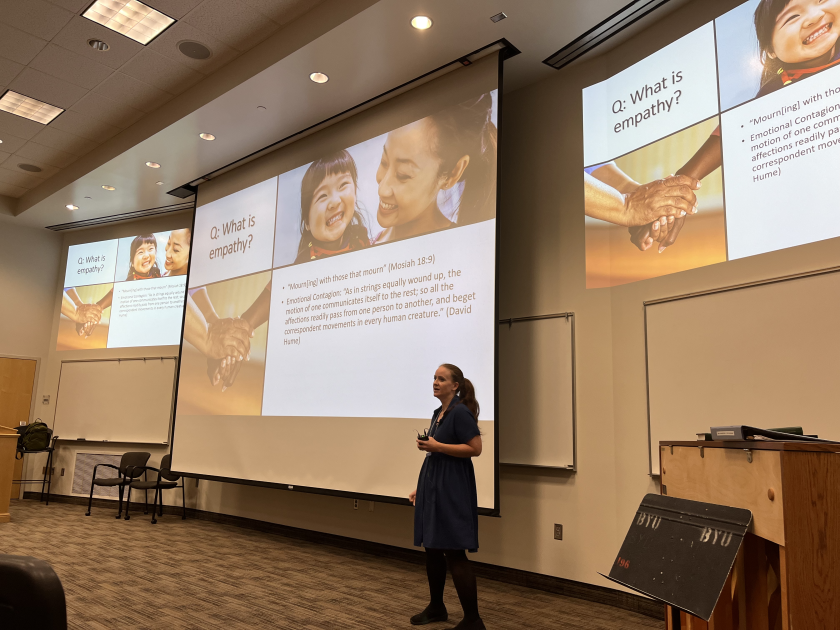College of Humanities faculty and staff shared gospel insights during Education Week.
Marvelous Things
by Emma Poulsen
Though filled to the brim with faithful Saints, conversations with the divine, and miracles beyond comprehension, the most miraculous thing about the Book of Mormon may be the book itself. In their lecture entitled “The Miraculous Coming Forth of the Book of Mormon,” Professors Jay and Donald W. Parry (Hebrew Bible and Dead Sea Scrolls) gave more detail and insight into why the wonders and marvels that brought forth the Book of Mormon have just as much significance as its contents.

Though many close to Joseph Smith thought it wouldn’t sell, nearly 200 years after publication, the Book of Mormon continues to distribute 5 million copies every year and has been translated into 115 languages. Jay Parry said that this world-wide influence “. . . is the power and destiny of the Book of Mormon” and that this destiny began with a multitude of wonders and marvels. As an example, he outlined the timeline and circumstances of the printing press making its way to Palmyra, New York, as one of only seven in the US, just in time for the Book of Mormon to be printed. He said, “For the first time in history, mass production of books was made possible.”
Jay and Donald W. Parry also highlighted the marvel of Smith’s family immediately accepting his divine calling as prophet, explaining that they “. . . never doubted his words for one minute.” The prophet was the target of violence and horrible slander for many years, but he was preserved long enough for his life to deeply impact others. He was helped by strangers, defended by friends and defectors alike. Maybe a casual observer could call these wonders and marvels a big heap of coincidences, but Jay and Donald W. Parry said, “These are marvelous things.”
The Duality of Conversion
by Tessa Swensen
Often, members of the Church use the word convert to mean a person who was baptized after the age of eight, but it could also refer to a person who’s continually making an effort to renew their faith and gospel understanding, regardless of when they got baptized. In his lecture, “The Cost of Conversion: A Convert’s Path to Christ,” given August 20, 2024, Josh Perkey (manager of digital media and communications for the College of Humanities), discussed what it means to be truly converted.

Baptized at 19 years old, Perkey knows what it’s like to be a convert to the Church and highlighted some of the challenges new Church members might face on their paths to conversion, such as dealing with spiritual struggles, learning new jargon, and making lifestyle changes. During his lecture, Perkey pointed out a startling statistic about new Church members: 50% go inactive within the first year and 85% go inactive within the first five years. So, what can we as fellow Church members do about this? According to Perkey, we must have grace for others and grace for ourselves because we are all on our own distinctive paths toward conversion.
Perkey pointed out that the decision to be baptized only begins the greater path of conversion: “Conversion is a process, and it’s also a moment we have this kind of conflict in our minds.” Because of the perpetual nature of this process, new converts must continuously wrestle with unfamiliar and sometimes uncomfortable gospel topics and truths, all while trying to understand where they fit within the gospel and the Church. However, in the midst of the struggles and adaptations, Perkey said, new converts can find peace in the simplicity of Christ and His Atonement.
Writing Lessons from the Prophets
by Emma Poulsen

As an English adjunct professor, Amanda B. Erdmann has given out many writing assignments, but none of them compare to the writing assignment God gave to the prophets who wrote the Book of Mormon. In her lecture “‘Thou Hast Not Made Us Mighty in Writing’: Being Obedient in Spite of Our Insecurities” on August 21, 2024, Erdmann explains there may be much to learn from the personal battles of the authors in the Book of Mormon.
Erdmann first found her love for the Book of Mormon when she saw it for what it really is—a book—and she loves books. As she read the Book of Mormon, she realized it was full of writers just like her and that they had struggles, just like she did. She said, “The writers of the Book of Mormon are real people—just like my students and just like you.” She explained that many of them express having difficulty writing, like Nephi, who said he was not “mighty in writing.”
She encouraged anyone in her audience who may have a fear of writing to face it head on, using Ether as an example. Ether had to come unto Christ, accept the comfort He gave him, and pray for grace and charity from his audience. She said that we can do the same when it comes to our own writing. Besides, she said, “Who knows what will happen with the writing you will do?”
Resilience in Stories
by Emma Mafi
Every family has its stories; some took place centuries ago and others only weeks ago, but regardless of their timeline, sharing these stories directly impacts a family’s growth. In adjunct professor Lori Steadman’s (Rhetoric and Composition) lecture on August 21, 2024, titled “How Does Knowing and Teaching Family Stories Promote Resiliency?,” she proposed family stories as a means to bring resilience into the home—not just for one generation but for many to come.

In her lecture, Steadman focused on two studies from 2023, both of which showed the benefits of family history. In the first, students who knew their family’s stories displayed a strong sense of identity. In the second, students linking ancestral records to their tree in a family history course recorded decreased anxiety levels and increased resilience by the end of the semester. With this research in mind, she said, “The single most important thing you can do for your family may be the simplest of all: develop a strong family narrative.”
Steadman explained that the most impactful stories have dialogue, descriptions, and plenty of detail. Above all, they must also have a moral. She said, “The more we identify with the character in our story, the more persuasive and powerful the story is.” By recording a clear and visualizable story—in journals or family history—generations of readers can find strength in some of our life’s most meaningful moments, passing up knowledge and support across generations. Steadman concluded, “Ties with ancestors increase family closeness, gratitude, miracles; such ties can bring help from the other side of the veil.”
Know Yourself, Know Empathy
by Emma Mafi
For most people, empathy means feeling someone’s emotions enough to understand them, at least partially. But on August 21, 2024, philosophy associate professor Katharina Paxman (Early Modern Philosophy) gave a lecture titled “Empathy and Knowledge,” where she gave a different definition. According to her, empathy exists as knowledge—knowledge that can help us develop Christlike compassion and love for those around us.
To truly empathize with others, Paxman argued we need to first understand ourselves. Looking at the two great commandments, she said, “Learning to love God properly involves understanding who we are . . . . We love God first because God will help us love ourselves [so] we’re in a better position to love others.” Once we understand ourselves—our own feelings, likes, dislikes, perspectives, etc.—we can understand others using the knowledge we learned from ourselves.

Paxman has studied empathy for years and, using the works of Scottish philosopher David Hume as a foundation, argued that striving to understand others precedes the development of Christlike love and empathy. She said, “If we engage in intentional empathizing. . . we engage in imaginative processes to try and understand what it would be like to be them.” Paxman noted that this practice will form beliefs which “[are] a source of information we can intentionally seek as we try to engage empathetically with other people.”
Paxman acknowledged that just because we understand ourselves doesn’t mean we understand others. She encouraged her audience to pray and listen to the whisperings of the Spirit, as well as to “continue talking to people, continue asking questions, continue to let them represent their story to us, and listen.”